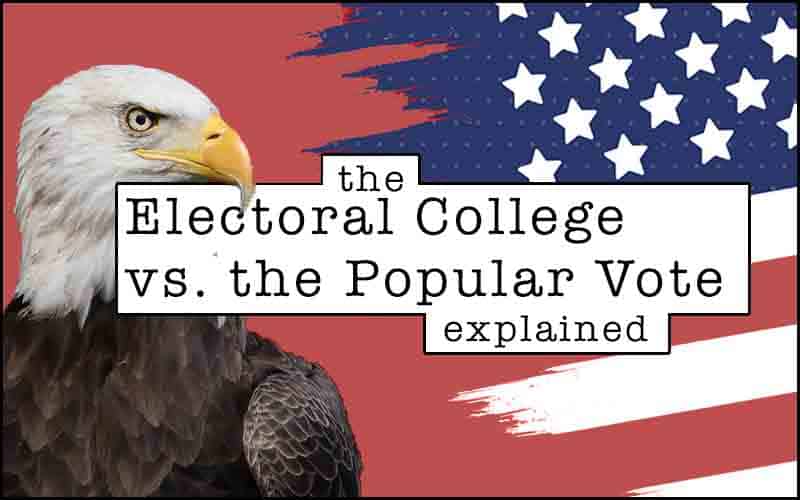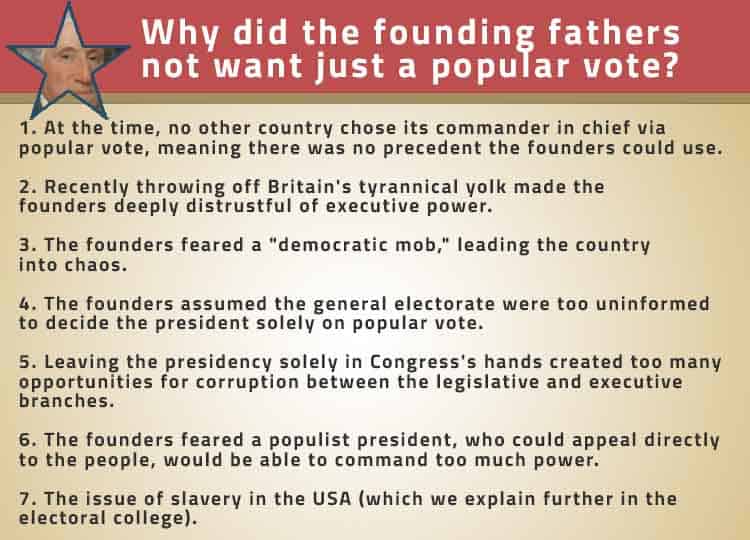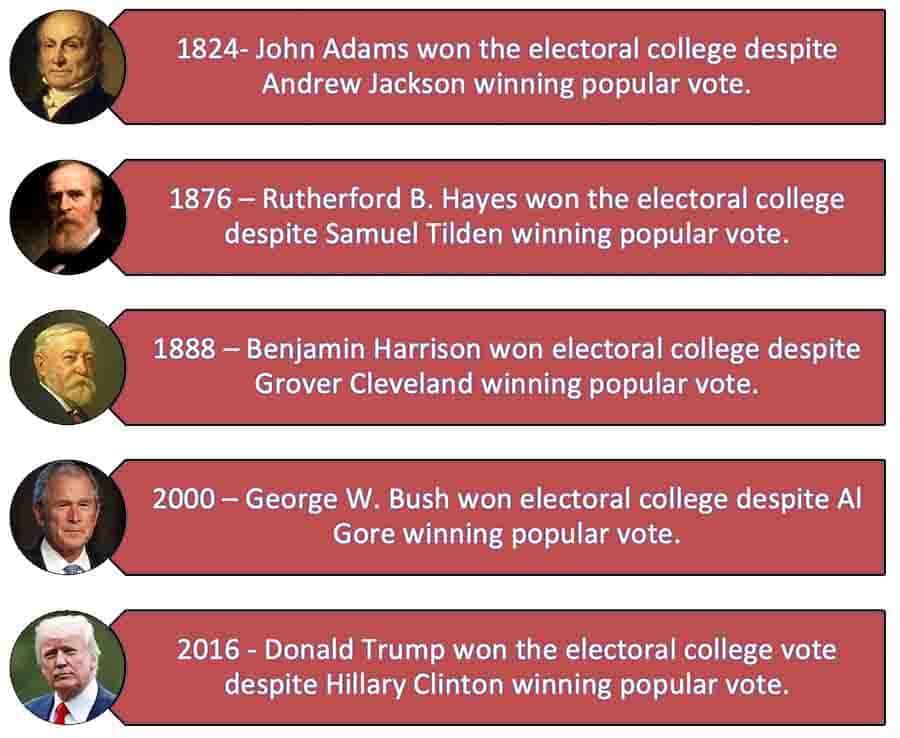Political Betting Informational Articles Understanding The Electoral College vs Popular Vote For Political Betting
Understanding The Electoral College vs Popular Vote For Political Betting

Our favorite sportsbooks frequently drop odds on who will win the electoral college and win the popular vote. You may see these betting lines presented as political prop bets. While many of these lines are enticing, it is vital to understand how the electoral college and the popular vote work. Our breakdown explains the electoral college’s nuances vs. the popular vote and answers our reader’s most poignant questions.
Popular Vote Explained
What Is the Popular Vote?
- Definition of the popular vote
- In many elections, the popular vote means the total number of individual votes for a candidate or an issue.
- To win a popular vote, a candidate must receive a simple majority, meaning the candidate received the highest number of casted votes than the second-highest number.
How Does the Popular Vote Work?
- Before we move into the popular vote in the US, let’s examine a simplified example.
- In a school, the students are voting on the class president. Each student votes, choosing one of two candidates: Tommy or Tara.
- Out of 500 students, 300 submit votes. Two hundred voted for Tara, and 100 voted for Tommy.
- We represented the numbers in the graphic below.

- Tara won a simple majority of votes and thus won the popular vote for school president.
- For the US Presidential election, the popular vote is the total number of eligible US voters in the 50 US states and Washington DC that cast their ballot for a presidential candidate.
- The candidate that received the simple majority of those votes wins the popular vote.
- Many of our favorite sportsbooks offer political prop bets on who will win the popular vote.
- To be an eligible voter in the US you must be a US citizen 18 years or older.
- Some states place further restrictions on voter eligibility. In most states, incarcerated individuals cannot vote, and many states don’t allow ex-felons to vote either.
History of Popular Vote
- The popular vote history dates back to the 1787 Constitutional Convention, where the founding fathers signed the US Constitution.
- At the time, the delegates of the convention debated over how to elect presidents.
- Two main methods were argued:
- 1) Congress should pick the president
- 2) A democratic popular vote should pick the president
- The popular vote and the electoral college vote were established simultaneously to allow a democratic vote and create an intermediary that would create more stability than only a popular vote.
- Two main methods were argued:

What Is the Popular Vote Interstate Compact?
- The National Popular Vote Interstate Compact (NPVIC) is an agreement among 15 US states and DC. It is an oath to award all that state’s electoral college votes to the presidential candidate that won the national popular vote in all 50 states plus DC.
- Currently, a state’s legislature has the authority to allocate electoral college votes in any method they see fit.
- Currently, most states allocate electoral college votes based on who won the popular vote in that state. The compact would change this method so that the total national popular vote distributes the electoral college votes.
- This is an effort by some states to circumvent the electoral college system, which allows for a candidate to lose the overall popular vote but still win the electoral college and, therefore, the Presidency.
Does the Popular Vote Matter?
- In short, yes, the popular vote matters.
- Even though the electoral college system makes it so that a single vote in a less populated state like Wyoming is technically worth more than a single vote in a heavily populated state like California.
- No matter the proportions, your vote is still worth something.
What is the point of the popular vote?
- The popular vote within each state decides how the electoral college allocates it’s votes nationally.
Who Won the Popular Vote in 2016?
- Hillary Clinton won the popular vote in 2016, despite losing the electoral college vote to Donald Trump.
What Percentage of the US Population Votes?
- On average, in the past 4 US elections, around 55% of total eligible US citizens voted.
Electoral College Explained
What Is the Electoral College?
- Definition of the electoral college:
- The electoral college is the constitutionally established body that decides the president and vice-president of the US.
- Each state has as many electors as it has representatives and senators in the US Congress.
Who Is the electoral college?
- What are electors?
- Electors are the actual people that represent a state’s electoral college votes. There is one elector per electoral college vote.
- How Many electors are in the electoral college?
- There are 538 total electoral college electors and votes. A presidential candidate needs a majority of 270 electors to win the Presidency.
- How many votes are in the electoral college?
- Five hundred thirty-eight votes, each corresponding to an elector.
How Does the Electoral College Work?
- How the Electoral College is chosen.
- The US Constitution outlines that each state has an electoral college but does not specify the method for choosing them.
- Most legislatures elect their slates of electors. Democrats and Republicans usually each put forth their own list.
- When a voter walks into the booth on election day, they vote for which slate of electors will go to the electoral college and vote.
- For example, in the 2016 election, voters chose between Hillary and Trump for the Presidency. Their vote doesn’t apply to the presidential candidate.
- Voters that chose Hillary voted for the Democrat’s list of electors so that the electoral college votes of those electors go towards Hillary.
- Voters that chose Trump voted for the Republican’s list of electors so that the electoral college votes of those electors go towards Trump.
What is the “winner take all” system?
- A crucial factor in understanding the electoral college is the “winner take all” system.
- This means that the electoral college vote doesn’t necessarily correspond to the popular vote across the country.
- We break down a hypothetical of how this works:
- A state with a higher population, meaning it has more Representatives in Congress (every state has two senators), will have 20 electoral college votes.
- A state with a lower population will have ten electoral college votes.
- Now let’s say there are five highly populated states with 20 or more electoral college votes but 30 lowly populated states with ten or less.
- Let’s assume 70% of the total population resides within those five highly populated states. And further, that all of those people voted for candidate A.
- 30% of the population lives in the less populated states, and we assume that all 30% voted for candidate B.
- So, 30% of the population provides at least ten electoral college votes times 30 states to equal 300 electoral college votes for Candidate B.
- 70% of the population provides at least 20 electoral college votes times five states to equal 100 electoral college votes for candidate A.
- In this hypothetical, imaginary US, even though Candidate A won 70% of the total voting populations vote (popular vote), Candidate B won the Presidency because the other 30 states gave Candidate B an electoral college majority.
- Hence, winner-take-all
What Is the Purpose of the Electoral College?
- The electoral college’s general purpose is to prevent an outright popular vote from choosing an unqualified president.
- This was the founding fathers’ original purpose, but they did not account for the partisan structure of elections today.
Electoral College History
- Origin of the electoral college:
- The founding of the US Constitution in Philadelphia, PA.
- When did the electoral college start?
- 1787, when the states ratified the US Constitution
Why create an electoral college?
- The electoral college served as an intermediary so that the president would not be decided by an outright popular vote or outright by Congress.
- The electoral college was also created to appease the Southern Slave-holding states. The southern slave states, some with 40-60% of their population being slaves, knew they would be in trouble if the election were up to a purely popular vote.
- If this were the case, only the white male voters in their states would count towards their voting population and the number of Representatives in Congress.
- With most of the Northern states’ voting population, Southern states feared the Northerners would win every election. Southern states pushed for the electoral college to protect the slave system.
- The constitution established the three-fifths compromise, where one slave equals three-fifths of a white man. Thus, Southern states could boost their population counts, representatives in Congress, and their electoral college votes to maintain power.
Electoral College Pros and Cons
- Should the electoral college be abolished?
- Of course, we can’t answer this question. For the electoral college to be abolished or changed, there must be a constitutional amendment that requires a two-thirds supermajority in Congress and ratification by three-fourths of the US states.
- Is the electoral college fair?
- This is also a judgment call. While the electoral college is a perfect system by no means, it does help create representation for the less-populated states.
What happens if a candidate doesn’t receive 270 votes?
- If neither candidate receives 270 electoral college votes, then the constitution mandates Congress to elect the president, awarding one vote per state delegation regardless of the number of Congressman.
- This is called a contingent election, and a candidate needs the votes of 26 states to win.
- This happened in the election of 1800 between Thomas Jefferson and Aaron Burr. Congress voted over 35 times before deciding a winner.
Who Won the Electoral College in 2016?
- President Donald Trump won the electoral college in 2016.
Electorial College Vs. Popular Vote
Can the Electoral College Vote Against the Popular Vote?
- In short, not really. Most states have laws and sanctions to penalize “faithless electors” or electors that vote outside of their oath to vote for their party’s winning candidate.
How Many Times Has the Popular Vote Lost to the Electoral College?
- Five times

Sources:
